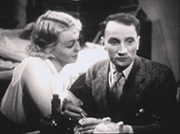A lone automobile arrives at an unassuming rural inn appropriately called the Frontier Café and Hotel on a bucolic northern border town, as a cheerful and genteel businessman named Meunier (Henri Guisol) provides a cursory orientation of the couple’s proximity to the border before bidding a sincere, fond farewell to his two visibly exhausted, but genial passengers, Amédée Lange (René Lefèvre) and Valentine (Florelle) who then promptly and unfussedly check-in and quietly retire to their rented ground floor room. Soon, the residents’ often idle and innocuous tone of morning conversation is set abuzz by a young man who notices a resemblance between the newly accommodated, mild-mannered stranger in the next room and the police profile and composite provided by the town constable earlier that day as he conducted door to door visits through all the local establishments in order disseminate information and track informational leads on a wanted fugitive named Lange. Noting the man’s physical semblance to the police photograph, the opinionated, independent-minded patrons – curiosity piqued – begin to discuss the appropriate course of action for their seemingly notorious guest. It is a spirited argument that is politely tempered when Valentine re-emerges from the adjoining room, having overhead the relevant subject of deliberation, and decides to join in the arguments by pleading her case against the town’s denunciation of Lang to the police. Proceeding in flashback, Valentine recounts Lange’s former life as a shy and fanciful aspiring cartoonist living vicariously through the adventures of his invented hero, Arizona Jim, at a working class boarding house while struggling to eke out a living as an illustrator for an opportunistic and disreputable publisher named Batala (Jules Berry).
Jean Renoir creates an elegantly fluid and deceptively lyrical, yet trenchant, complexly interwoven, and socially incisive portrait of exploitation, community, mutualism, and justice in The Crime of Monsieur Lange. Integrating episodes of caricatured, pulp comic imagery against the subtle observations of the travails and minutiae of existence, Renoir illustrates the inherent dichotomy between Lange’s escapist, adventure-seeking fictional hero (who, due to Batala’s insidious marketing ploy, is compelled to routinely ingest a mass marketed pill for courage) and the modern-day heroism of everyday struggle, communal loyalty, and personal sacrifice: Lange’s role-playing adventures of the exoticized Arizona frontier from his rented room that contrasts with his somber arrival at the north border frontier in the beginning of the film; his publicity photography sessions for the comic book series that emphasize the artificial and illusory nature of his craft; the townspeople’s casual conversation on their abstract, murder fantasies that is weighed against a personal account of complicity that results in death. Note the idiosyncratic, ripped paper wipe cut that transitions from Batala’s encounter with Estelle (Nadia Sibirskaïa) to a shot of Lange paying a visit to the landlord’s incapacitated son Charles (Maurice Baquet) – a scene that lucidly reflects the separation between fantasy and reality – differentiating between Lange’s grandiose (albeit improbable) actions (in his playful boast of a new sexual conquest) and truly noble gestures (as he comforts a lovelorn Charlie by claiming deception). It is this intrinsic irreconcilability between appearance and reality, concocted ideas and practical application, death-defying feats and acts of true humanity, that inevitably define Valentine’s impassioned argument: not to trivialize the dubious nature of Lange’s crime, but to reflect on the true meaning of courage and, in the process, achieve a sense of personal redemption through human reason, compassion, and shared responsibility.
© Acquarello 2004. All rights reserved.
